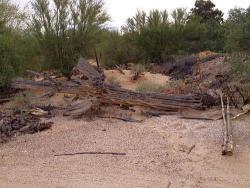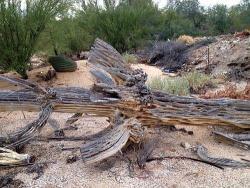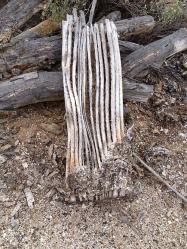The demise of Saguaros in habitat.
It is mostly the giant multi-arm plants that die of natural causes. Some simply die of old age
(depending on the source, estimated to be well over one hundred years old). Because of their bulk
-- thirty foot+ (10 meters+) mature plants with multiple arms weigh several tons (mucho Kilograms)
and are sometimes blown over due to the high winds that often accompany our summer thunderstorms
They then rot away on the ground (it takes a long time). Some plants (young and old) succumb due to
injuries resulting from humans who damage them by shooting guns, arrows, spears (and throwing rocks)
etc. at them. While such behavior is despicable (and unlawful) at any time it is especially harmful
during the rainy season when such wounds often result in the start of fatal rot. Fortunately during
arid conditions (most of the year) the wounds soon heal although the plants are left with unsightly
scars. It is interesting to note that most mature plants in habitat are naturally pock marked by
Woodpeckers who hollow out their nests in the sides of (usually) branch stems (later occupied by pygmy
owls, etc.) -- they only do that in the dry seasons so they do not induce rot -- Nature doesn't miss a trick!
The falling giants come crashing down to the desert floor and soon start to decay. But again, like everything
in Nature, their demise does not result in waste of valuable resources. The decaying vegetative parts provide
nutritious food for a host of lizards, insects and small rodents and the hollow stem interiors become a cozy
dwelling place for their predators -- esp. scorpions, spiders (tarantulas, brown recluse, black widow, et al).
and constrictor snakes (desert king snakes and gopher snakes, etc.). Nothing goes to waste. Eventually all that
remains is a skeleton of "woody ribs". They also do not go to waste, for as they slowly crumble away the smaller
fragments are used by birds and small rodents to build nests, etc. Native American people have used Saguaro ribs
in constructing dwellings (especially roof supports) for countless generations -- now they are quite popular for use
by builders of modern "rustic south-western" homes. Saguaro wood is not very hard but it quickly dulls the edges
of woodworking tools due to the high concentration of silica -- you can see the cut surfaces glinting in bright sunlight.
Some thicker ribs also make great walking sticks.

Skeleton of fallen giant

Close-up of Skeleton of fallen Saguaro

Close-up of ribs of skeletal Saguaro
James


